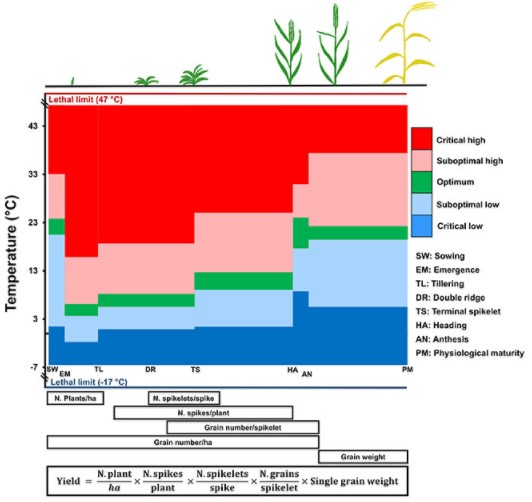By Stefan Siebert
Information on the extent to which crop yields are affected by specific extreme weather events is important for the insurance sector, food security studies, climate change impact assessments, guiding extension services and policy making, or supporting crop breeding efforts, say Stefan Siebert and colleagues.
Weather effects on crop yields are manifold, making their assessment challenging. Information on the extent to which crop yields are affected by specific extreme weather events is important for many applications such as in the insurance sector, food security studies, climate change impact assessments, to guide extension services and policy making or support crop breeding efforts.
In a recent article, Zampieri et al [1] propose a method to study the impact of heat, drought and water excess on wheat yields at the global scale, with a demonstration of their method's robustness with subnational yield data for France. The article represents an important contribution, advancing previous research by using a non-parametric approach to disentangle and quantify effects of heat and soil moisture anomalies on wheat yield. The approach requires neither prior knowledge of the statistical distributions of weather variables nor assumptions about predefined thresholds to calculate heat or water stress. As such, their composite heat and water stress index, Combined Stress Index (CSI), is mainly data driven and straightforward to apply. The heat stress index, Heat Magnitude Day (HMD), is calculated using daily maximum temperatures (Tmax) and their 25th, 75th and 90th percentiles in a two week time window for the period 1980–2010. In a similar manner, stress arising from drought and excess water are quantified using the Standardized Precipitation Evaporation Index (SPEI) in which precipitation and potential evaporation in a specific year are compared to long-term (1980–2010) time series. HMD is accumulated for a period of three months before harvest, while SPEI is determined for six months before harvest. Both indices are combined in the CSI which is then correlated with global, national or subnational wheat yields and production.
Zampieri et al [1] found that linear correlation between total global wheat production and globally averaged CSI explained 42% of the total variability in wheat production. Variability in national crop yields was strongly associated with heat anomalies in Central Europe, Russia, Argentina and Southern Canada. Yield anomalies in the Mediterranean region and Central Asia were strongly associated with drought while water excess was found to be more relevant for Northern and Western Europe and humid tropical regions. Furthermore, the authors found that the effects of heat are comparable or even larger than the effects of water stress for most countries.
While acknowledging the research progress on heat and water stress impacts on crop yield made by Zampieri et al [1], we also point to some deficiencies and uncertainties. The non-parametric approach used by Zampieri et al [1] has the advantage that assumptions about temperature and moisture thresholds causing stress and yield loss are not required but are determined implicitly. The challenge is then however to interpret spatial differences in these automatically determined thresholds, such as the 90th percentile of Tmax (figures S4 and S5 in Zampieri et al [1]) used in the calculation of the heat stress indicator. The methodology used by Zampieri et al [1] is based on a comparison of temperature and moisture in a specific year to long-term data for the same location. This would suggest that similar temperature and moisture in a specific year can cause completely different stress and yield response at distinct locations, and barring widely divergent vapour pressure deficit conditions. This is difficult to explain from a crop physiological perspective. Further, regression parameters derived when estimating CSI (equation (2) in Zampieri et al [1]) vary for each country and can also be expected to vary depending on the time period analysed. This makes it difficult to use these relationships for projections, for example in climate change impact assessments. Using statistical relationships between weather variables and crop yield is appropriate to detect associations between variables but, due to the risk of confounding effects, these associations cannot explain causal relationships as variables contained in the statistical regression equations could be correlated with other variables not considered in the analysis, such as vapour pressure deficit [2].

The approximation of heat and water stress effects on crop yield by a single combined stress indicator is a strong simplification of reality. The range of the optimum, as well as sub-optimum and critical high and low temperatures, vary considerably both between processes and crop development phases of wheat [3–5]. Relatively warm conditions are required for germination, followed by low temperatures in the vegetative development with increasing temperature optima in subsequent development phases (figure 1). The impact of temperature anomalies in a specific year on wheat yield also depends on how well the long-term mean conditions in the analysed region fit to the optimum ranges shown in figure 1. While a relatively good agreement between long-term climate and optimum conditions can be expected in highly productive regions like Western Europe, poor agreement in regions with marginal production can result in a higher sensitivity to climate anomalies in specific development phases. Additionally, the sensitivity of crop yield to temperature and moisture anomalies also depends on the specific processes (figure 2) and yield components (figure 1) affected. Suboptimal or critical conditions tend to have large impacts on crop yield in the period around anthesis [5–7]. Suboptimal conditions in early development stages can be partially or completely compensated by many different mechanisms when the growing conditions in subsequent development phases are favourable.
Click here to see more...